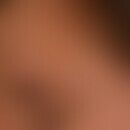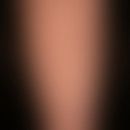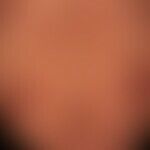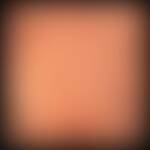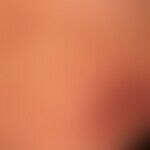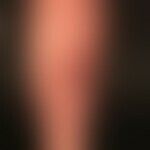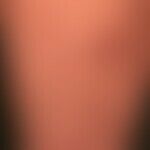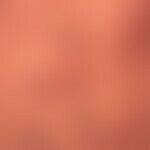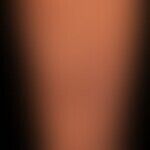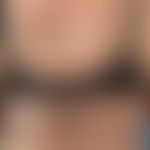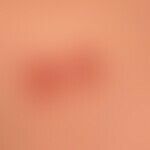Synonym(s)
HistoryThis section has been translated automatically.
The disease was first described by Haraway in the USA in 1880. Subsequently, in France, Lailler, Brocq, de Beurmann, Hallopeau described the disease casuistically. Brocq describes it under the title Lichen corneus obtusus. In the German literature Fabry, Kreibich Hübner and Brill are listed among the authors. Hyde & Montgomery proposed the name prurigo nodularis in 1909, which later became accepted.
DefinitionThis section has been translated automatically.
Very rare, chronic, polyetiologic systemic disease characterized by numerous, large, intensely pruritic (or also painful) plaques and nodules, which is regarded as the maximum form of prurigo simplex subacuta (or nodular variant of lichen simplex chronicus) (remark: many authors emphasize the etiogenetic independence of prurigo nodularis).
Characteristic for this disease is an almost unbreakable cycle of itching/pain, uncontrollable scratching. From lesional scratching effects with reactive skin changes (inflammation, acanthosis, fibrosis, increased density of substance P-positive nerves) and a again flaring itching/pain (Tsianakas A et al. 2016).
Clinically, malignant tumor diseases (e.g., lymphogranulomatosis of the skin; cutaneous T-cell lymphoma) should be excluded. Renal and hepatic insufficiency, diabetes mellitus and gluten sensitivity should be clarified (Suárez C et al. 1984).
A highly chronic course over several years (decades) is predictable and must be taken into account when planning therapy.
You might also be interested in
EtiopathogenesisThis section has been translated automatically.
Unknown.
A sensorimotor peripheral polyneuropathy induced by multiple factors and often subclinical is discussed (Hughes JM et al. 2020). It has been shown that a reduced intraepidermal nerve fiber density (IENFD) is present in the skin changes of prurigo nodularis (see also small fiber neuropathy). Increased expression of nerve growth factor (NGF), matrix metallo-proteinases, the chemokine CXCL2 and insulin-like growth factor 1 has been detected.
The effects and associations of gluten sensitivity on this disease have received little attention and research to date.
The pathogenesis of prurigo nodularis also involves a form of "neuronal sensitization", whereby the itch/pain-processing nerve cells are triggered and activated, thereby maintaining an "itch-scratch cycle".
An inflammatory reaction in the skin and neuronal plasticity also play a role. Histopathologically, there are changes in the nerve fibers in the skin and inflammatory cells in the dermis. The itching/pain in this disease can be triggered by the release of tryptase, interleukin-31 (IL-31), prostaglandins, eosinophil cationic protein (ECP) and neuropeptides by inflammatory cells, mast cells and nerve fibers.
Recent studies show that an up to 50-fold increase in the production of interleukin-31 mRNA can be detected in the prurigo nodules. Studies on patients with atopic dermatitis and prurigo nodularis suggest that interleukin-31 released by activated CD4-positive T cells is a major trigger of itching/pain in these diseases. Interleukin-31 is already referred to as the"itch cytokine".
Furthermore, oncostatin M (OSM) plays a role as a mediator of inflammatory reactions of the skin as well as hyperkeratosis and fibrosis. The number of dermal OSM receptor β-cytokine receptor subunit (OSMRβ) (+) cells is increased in prurigo patients. Vixarelimab, a humanized blocker of this cytokine receptor, is currently undergoing clinical trials.
The IL-31 receptor A is most strongly expressed in the sensory nerve cells of the spinal ganglia of the spinal cord. Interleukin-31 also activates signal transducers of the JAK-STAT signaling pathway (JAK1 and JAK2), which in turn can induce itching.
ManifestationThis section has been translated automatically.
LocalizationThis section has been translated automatically.
Sacral area (50%), abdomen (40%), extremity extensor sides bilaterally, soles and palms always remain free. Face is rarely affected. The mucous membranes close to the skin are never affected. Nail lesions are absent.
ClinicThis section has been translated automatically.
Disseminated, mostly symmetrically arranged, calotte-like raised, 0.3- 2.0 cm large, rough, initially slightly or more reddened with prolonged persistence, red-brown to dirty gray, excruciatingly burning-itching (itching is described as burning pain ) roundish, firm papules and nodules. The itchy burning pain persists continuously or alternates periods of relative calm with periods of unbearable itching.
The papules and nodules are generally sharply defined. They maintain a defined distance from each other and do not confluent. The interlesional skin remains intact. A Köbner phenomenon cannot be observed. However, there is a certain linearity in the distribution pattern.
This results in a conspicuously ordered, topographical basic pattern, which shows the nodular or papular efflorescences in an otherwise unaltered skin. The papules/nodules are often excoriated or exulcerated by deliberately placed sharp spooning (linear scratch marks indicating uncoordinated scratching, such as in atopic dermatitis, do not exist), whereby the lesions are levered out to the deep corium with fingernails or suitable objects. This provides the patient with considerable relief. A later onset of wound pain is described as more bearable.
In older nodules, there is a tendency towards keratotic or verruciform, even bifurcated surface structures. Other signs of an underlying skin disease (e.g. indications of atopic, psoriatic or lichen planus diathesis) are absent.
HistologyThis section has been translated automatically.
Pronounced, plump acanthosis with irregular elongation of the mostly colbulous distended rectal ridges. Marked proliferation of the adnexal epithelia. There is overall aspect of pseudoepitheliomatous hyperplasia. Vigorous orthohyperkeratosis with focal parahyperkeratosis. Widespread capillaries are evident in the stratum papillare as well as in the upper dermis. In addition, there are predominantly vascular, but also diffuse, rather sparse lymphohistiocytic infiltrates, occasionally intermixed with eosinophilic leukocytes. In erosions, plasma cells and neutrophilic leukocytes are also found. There is usually marked fibrosis of the dermis, with collagen bundles running perpendicular to the epidermis. Repeated evidence of schwannoma-like neural hyperplasias(Pautrier's neuromas).
Differential diagnosisThis section has been translated automatically.
Prurigo simplex subacuta (no lump formation, only nodules, identical itching)
Prurigo form of atopic eczema (detectable signs of atopic eczema)
Lichen planus verrucosus (to be verified histologically, usually lower leg; look for other lichen planus lesions)
Prurigo form of bullous pemphigoid (DIF to be clarified, flat nodule formation, possibly blistering)
Multiple eruptive keratoacanthomas (eruptive onset, itching absent, typical clinic of keratoacanthoma with central horny plug)
General therapyThis section has been translated automatically.
Therapeutic results of all known therapeutic measures are unsatisfactory. In almost all patients, topical cortisone preparations fail after initial slight success, and antihistamines are also ineffective.
Cooperation with a psychologist or a psychiatrist is necessary to improve the (reactively) depressive attitude of the patient. Especially in prurigo nodularis patients suffer more from anxiety, depression and have more suicidal thoughts.
A therapeutic approach with tricyclic antidepressants can be helpful in coping with the disease.
A new approach is the treatment with nemolizumab, which showed good results in a phase II trial at Münster University Hospital in 2020 as part of the drug approval process. The compound has recently been approved (Williams KA et al. 2021).
External therapyThis section has been translated automatically.
Short-term highly potent external glucocorticoids such as 0.1% mometasone ointment (e.g. Ecural) or 0.05% clobetasone cream (e.g. Dermoxin) under occlusion.
If without effect, multiple, potwise, intralesional application of triamcinolone (draw up 10 mg Volon A together with 1-2 ml 1% scandicaine, take your time when injecting, use a thin needle).
Sublesional application is easier but useless. In addition, there is a risk of fat tissue atrophy in women!
There have been reports of success with ablative laser systems, see below. Here, the principle of "eradication" of the lesion with subsequent scar healing is effective.
Radiation therapyThis section has been translated automatically.
In case of atopically superimposed clinical picture try phototherapy (UVB or UVA1), balneophototherapy, PUVA therapy, systemic or local (as balneophotochemotherapy).
Internal therapyThis section has been translated automatically.
Sedating antihistamines such as hydroxyzine (e.g. Atarax) 1-3 tbl./day p.o. Dimetindene (e.g. Fenistil) 2 times/day 1 drg. p.o. or Clemastine (e.g. Tavegil) 2 times/day 1 tbl. p.o. are first choice therapeutics.
In case of resistance to therapy: therapy with methotrexate - 15-20mg/week s.c. ( off-label use)
Alternative:
- Ciclosporin A (3.0-5.0 mg/kg bw/day).
- Trial with thalidomide 200 mg/day ( off-label use)
- Further therapeutic options are amitriptyline or gabapentin (= anticonvulsant; e.g. Gabapentin STADA) initially 1 time/day 300 mg, increase to 3 times/day 300 mg p.o.; further dose increase if necessary, with intact kidney function (check kidney parameters!), by 300 mg/day up to a maximum dose of 3600 mg/day in 3 ED.
- Pregabalin (Lyrica®) and the neurokinin-1 receptor antagonist aprepitant.
- Dupilumab; in cases of absolute resistance to therapy, a trial with dupilumab is recommended. Very good results have been described with this therapy (Calugareanu A et al. 2019). (According to our own findings, this therapeutic approach is superior to any previously used therapeutic measure)
Nemolizumab: With the humanized interleukin-31 receptor antibody nemolizumab (Nemluvio®-Fa. Galderma), which binds to IL-31 receptors (see IL31RA below), including the IL-31 receptors on neurons (Ständer S et al. 2020), a significant reduction in itching could be achieved with monthly doses (Ruzicka T et al. (2017). Nemolizumab has now received EU approval for the indication"atopic dermatitis" (moderate to severe atopic dermatitis) and prurigo nodularis. This is based on the results of the pivotal Phase III studies ARCADIA 1 and 2 (n=1700 patients) and OPLYMPIA 1 and 2 (n=560 patients). The preparation is injected every 4 weeks in the form of prefilled pens/ready-to-use syringes.
In clinical trials:
- Tofacitinib: A clinical trial of the Janus kinase inhibitor (JAK inhibitor) tofacitinib is available (Molloy OE et al. 2020). Tofacitinib has an immunomodulatory/immunosuppressive effect and was primarily developed for the treatment of moderate to severe active rheumatoid arthritis.
- Povorcitinib: Positive results from a Phase 2 study are available for this Janus kinase inhibitor (Kwatra S. 33rd EADV Congress - Amsterdam 2024 - Presentation D2T01.3F).
- Vixarelimab (anti-oncostatin M receptorbeta-mAk) currently in Phase II trials.
- Nalbuphine (kappa-opioid receptor agonist and u-opioid receptor antagonist) currently in Phase II trials
There are also positive case reports for CPG/PN with the Janus kinase (JAK) inhibitors(baricitinib, upadacitinib) and a small ongoing study with abrocitinib (NCT05038982)
Operative therapieThis section has been translated automatically.
Cryosurgery (2-fold cryocycle in open spray procedure), electrocoagulation or laser therapy( dye laser).
Note: Surgical measures lead tolocal destruction with consecutive scarring (including destruction of dermal nerve structures). Such eradications remain (in a systemic disease) always only localized measures.
In this respect, reports on a general healing of prurigo nodularis after surgical measures are to be evaluated with scepticism!
Progression/forecastThis section has been translated automatically.
Highly chronic course characterized by considerable resistance to therapy. Spontaneous healing is very rare. The single-cell florescence heals with shallow scarring.
Note(s)This section has been translated automatically.
Although the clinical picture of the (very rare) nodular Prurigo can be well differentiated from the nodular Prurigo simplex subacuta, this differentiation is often not made in international literature. However, our own experience confirms the entity of the clinical picture in several cases.
LiteratureThis section has been translated automatically.
- Ahmed E et al (1997) Cyclosporine treatment of nodular prurigo in a dialysis patient. Br J Dermatol 136: 805-806.
- Calugareanu A et al (2019) Dramatic improvement of generalized prurigo nodularis with dupilumab. J Eur Acad Dermatol Venereo 33:e303-e304.
- Fostini AC et al (2013) Prurigo nodularis: an update on etiopathogenesis and therapy. J Dermatolog Treat 24:458-462.
- Hughes JM et al (2020) Association between Prurigo Nodularis and Etiologies of Peripheral
- Neuropathy: Suggesting a Role for Neural Dysregulation in Pathogenesis.
- Medicines (Basel) 7:4.
- Hyde JN, Montgomery FH (1909) A practical treatise on disease of the skin for the use of students and practitioners. Lea & Febiger, Philadelphia, pp. 174-175.
Kwon CD et al (2019) Diagnostic workup and evaluation of patients with prurigo nodularis. Medicines (Basel) 6:97.
- Lotti T et al (2008) Prurigo nodularis and lichen simplex chronicus. Dermatol Ther 21:42-46
- Molloy OE et al (2020) Successful treatment of recalcitrant nodular prurigo with tofacitinib. Clin Exp Dermatol 45: 918-920.
- Ruzicka T et al: Anti-interleukin-31 receptor A antibody for atopic . N Engl J Med 376: 826-35.
- Siepmann D (2008) Antipruritic effect of cyclosporine microemulsion in prurigo nodularis: results of a case series. JDDG 6: 941-946
- Spring P et al (2014) Prurigo nodularis: retrospective study of 13 cases managed with methotrexate. Clin Exp Dermatol 39:468-473
- Ständer S et al (2020) Trial of nemolizumab in moderate-to-severe prurigo nodularis. N Engl J Med 382:706-716.
- Stefanini G et al (1999) Prurigo nodularis (Hyde's prurigo) disclosing celiac disease. Hepatogastroenterology 46:2281-2284.
- Suárez C et al (1989) Prurigo nodularis associated with malabsorption. Dermatologica 169:211-214 .
Szymanski K et al (2022) Case Report: Pemphigoid Nodularis-Five Patients With Many Years of Follow-Up and Review of the Literature. Front Immunol 13:885023.
Tanis R et al (2019) Dupilumab Treatment for Prurigo Nodularis and Pruritis. J Drugs Dermatol 18:940-942.
Theodoridis A et al (2013) Malignant atrophic papulosis (Köhlmeier-Degos disease) - a review. Orphanet J Rare Dis 8:10.
- Tsianakas A et al (2016) Prurigo nodularis management. Curr Probl Dermatol 50:94-101.
- Vaidya DC et al (2008) Prurigo nodularis: a benign dermatosis derived from a persistent pruritus. Acta Dermatovenerol Croat 16:38-44.
- Wieser JK et al (2020) Resolution of Treatment-Refractory Prurigo Nodularis With Dupilumab: A Case Series. Cureus 12:e8737
- Williams KA et al.(2021) Pathophysiology, diagnosis, and pharmacological treatment of prurigo nodularis. Expert Rev Clin Pharmacol 14:67-77.
- Woo PN et al (2000) Nodular prurigo successfully treated with the pulsed dye laser. Br J Dermatol 143: 215-216.
- Zeidler C et al (2021) Chronic prurigo: Similar Clinical Profile and Burden Across Clinical Phenotypes. Front Med (Lausanne) 8:649332.
Incoming links (35)
Aprepitant; Chronic lymphocytic leukemia; Collagenosis reactive perforating; Cxcl2; Diabetic pruritus; Dupilumab; Dystrophic epidermolysis bullosa pruriginosa recessive; Gabapentin; Granulocyte eosinophile; Hodgkin's lymphoma, skin manifestations; ... Show allOutgoing links (48)
Abrocitinib; Amitriptyline; Antihistamines, systemic; Aprepitant; Atopic dermatitis (overview); Baricitinib ; Ciclosporin a; Clemastine; Cryosurgery; Cxcl2; ... Show allDisclaimer
Please ask your physician for a reliable diagnosis. This website is only meant as a reference.

